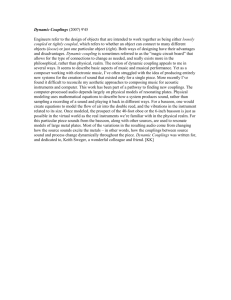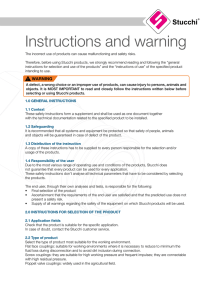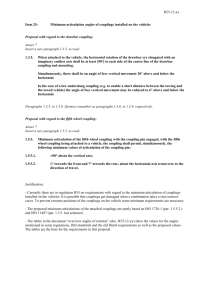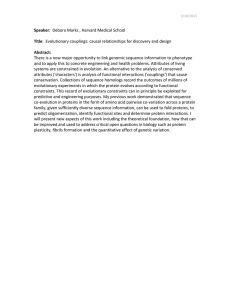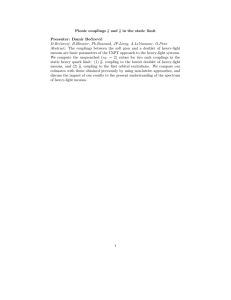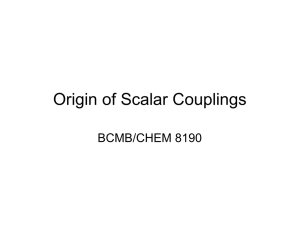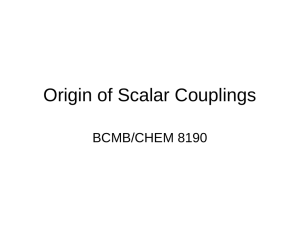CPR Fat Face – Warnings
advertisement
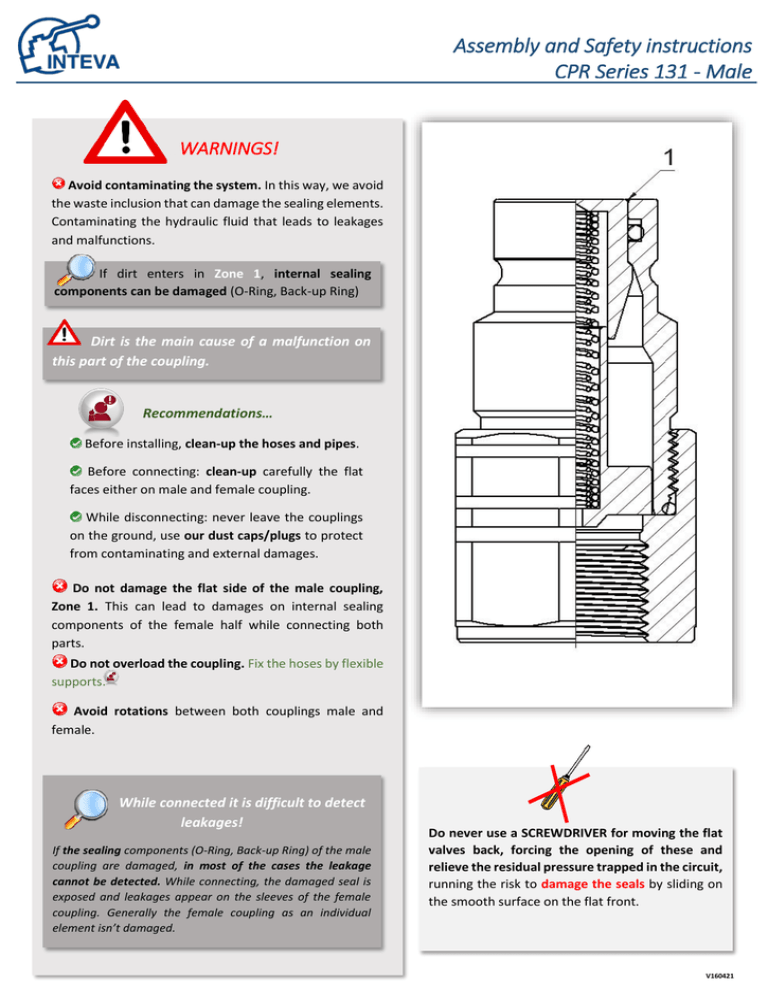
Assembly and Safety instructions CPR Series 131 - Male WARNINGS! Avoid contaminating the system. In this way, we avoid the waste inclusion that can damage the sealing elements. Contaminating the hydraulic fluid that leads to leakages and malfunctions. If dirt enters in Zone 1, internal sealing components can be damaged (O-Ring, Back-up Ring) Dirt is the main cause of a malfunction on this part of the coupling. Recommendations… Before installing, clean-up the hoses and pipes. Before connecting: clean-up carefully the flat faces either on male and female coupling. While disconnecting: never leave the couplings on the ground, use our dust caps/plugs to protect from contaminating and external damages. Do not damage the flat side of the male coupling, Zone 1. This can lead to damages on internal sealing components of the female half while connecting both parts. Do not overload the coupling. Fix the hoses by flexible supports. Avoid rotations between both couplings male and female. While connected it is difficult to detect leakages! If the sealing components (O-Ring, Back-up Ring) of the male coupling are damaged, in most of the cases the leakage cannot be detected. While connecting, the damaged seal is exposed and leakages appear on the sleeves of the female coupling. Generally the female coupling as an individual element isn’t damaged. Do never use a SCREWDRIVER for moving the flat valves back, forcing the opening of these and relieve the residual pressure trapped in the circuit, running the risk to damage the seals by sliding on the smooth surface on the flat front. V160421 Assembly and Safety instructions CPR Series 131 - Female WARNINGS! Avoid contaminating the system. In this way, we avoid the waste inclusion that can damage the sealing elements. Contaminating the hydraulic fluid that leads to leakages and malfunctions. If dirt enters in Zone 1, 2 or 3, following failures can appear: 1. Male half and female half cannot be engaged. 2. Dirt can damage internal component 4. When connected, female leaks. 3. If dirt enters in Zone 5 it can affect the back movement of the sleeve what leads to an inappropriate connection between both halves. 4. Ensure pulling the sleeve totally down for a safety disconnection. Dirt is the main cause of a malfunction on this part of the coupling. Recommendations… Before installing, clean-up the hoses and pipes. Before connecting: clean-up carefully the flat faces either on male and female coupling. While disconnecting: never leave the couplings on the ground, use our dust caps/plugs to protect from contaminating and external damages. Decompression… If female coupling is pressurized and pressure cannot be relieved by a control unit, the decompression of the female coupling is not possible. V160421 Assembly and Safety instructions Quick Couplings Before installation!!! Read carefully the assembly and safety instructions. Installation of Quick Couplings can be only done by well qualified personnel. Check whether the product meets the requirement and if it has been damaged during transport. Ensure that quick coupling is suitable for installation, required pressure, connection, flow characteristic and is compatible with the medium used. Before installation clean up hose and pipes. Check that line temperature work within permitted limits. Verify if maximal working pressure is equal or higher than the peak pressures of the application. Verify that the number of cycle impulses of the product is compatible with those of the application. Warnings!!! Avoid contaminating the hydraulic system. Contaminated mediums can damage internal sealing components leading to leakages and malfunctions. Before installation clean up hose and pipes. Before connection clean up both halves male and female. After disconnection use our dust caps and plugs to protect the couplings from dirt and external damages. Lateral loads, vibration and mechanical stress in general, can cause misalignment of couplings during connection / disconnection and can cause unwanted disconnection, damage the connection and sealing. It reduces significantly the life of the product. We recommend using flexible hoses. Do never use inappropriate tool e.g. clamp tools, hammers, key tools. It can damage the couplings leading to malfunction. While disconnecting, depending on the positioning and temperature the residual pressure can reach high values. Do not use any tool to force the disconnection and relieve the pressure trapped inside. Start-up!! Installation of Quick couplings can be only done if the circuit is depressurized. Make sure the energy supply is disconnected. Always wear protective clothing. Use flexible hoses to withstand better the system vibration and mechanical tensions on the couplings. Use appropriate tools to act only over flat sides of the couplings Hose must be installed so that the connection/disconnection can be done easily and aligned position. Make sure to work always within permitted limits on pressure and temperature. Lubricate the seals and run always a test connection to ensure both halve connect correctly. Connect screw couplings always up to the stop mark. Storage All our quick and screw couplings are brought through a heat and surface treatment to improve its conservation. We recommend: Store in cool, dry, and high places above the ground. Keep away from heat sources or direct impact of the sunlight. Review periodically the valves whether these have signs of corrosion, cracks and/or visible damages. Maintenance To avoid unexpected damages, run regularly inspections. If during inspection or first runs following conditions are detected, system should be turned off and the product replaced: Malfunction Presence of leakage Visible damages, cracks and or corrosion Difficulties by connecting/disconnecting System contamination Sealing components should be lubricated with compatible lubricant. The maintenance period should be defined by the end user depending on the type of application and operating conditions. The functionality of the product can be affected by a wrong maintenance. Operating over and under the permitted working pressure and temperature limits, leads to deterioration and leakages of the quick couplings. Do not connect and disconnect at temperatures < 80ºC. Operating between 30ºC – 80ºC use gloves and other safety devices to prevent injury itself, thirds, animals and/or objects. Never rotate the couplings while under pressure. Use care if you must install quick couplings onto iron pipe. In case of malfunction, quick coupling must be replaced by qualified personnel. First depressurize and drain the system. If necessary, out of service. If our quick couplings are dismantled improperly without authorization, any warranty and damage claim against the manufacturer are null and void. Any changes on design or reworks on quick couplings e.g. dimensional or superficial, is strictly prohibited without previous consultation with the manufacturer. . This manual is not intended to replace any national regulation on accident prevention and local safety regulations of the operating company, which on this should be considered a priority. INTEVA and its distributors are not responsible for damages caused on people or machines for an improper use or incorrect maintenance of the products. The product selection, installation, maintenance and use, is under end users responsibility. The distributor must ensure that that all product requirements are met and must inform the end user about the product use and maintenance. Elimination In compliance with the laws of each country on the disposal of industrial waste, the quick couplings in disuse must be eliminated taking into account that all components can be recycled. Consider that: Elimination and removal must be done by qualified personnel only. Before extraction, depressurize pipes and circuit. The quick couplings must relieve pressure from its cavity as well. V160421
